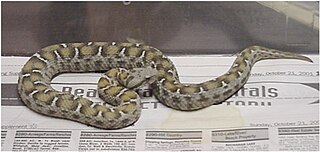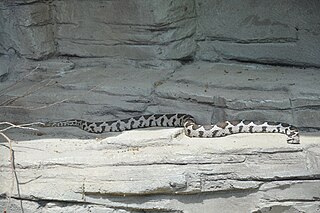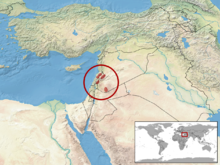
Macrovipera lebetinus, known as the blunt-nosed viper, Lebetine viper, Levant viper, and by other common names, is a viper species found in North Africa, much of the Middle East, and as far east as Kashmir. Like all other vipers, it is venomous. Five subspecies are currently recognized, including the nominate race described here.

Macrovipera, known as the large Palearctic vipers, is a genus of vipers that inhabit the semideserts and steppes of North Africa, the Near and Middle East, and the Milos Archipelago in the Aegean Sea. Like all other vipers, they are venomous. These snakes are responsible for a number of bites in Africa and Western Asia every year. They have a reputation for being ill-tempered and can inject a lot of venom, which is why they should be considered as very dangerous. Two species are currently recognized.

Montivipera albizona, the central Turkish mountain viper, is a viper species endemic to the mountainous regions of central Turkey. Like all other vipers, it is venomous. No subspecies are currently recognized.

Macrovipera lebetinus schweizeri, commonly known as the Milos viper or Cyclades blunt-nosed viper. is a subspecies of venomous snake in the family Viperidae. The subspecies is endemic to the Cyclades Archipelago of Greece in the Aegean sea.

Montivipera raddei albicornuta is a venomous viper subspecies endemic to Iran. It is a subspecies of Montivipera raddei.

The Mount Bulgar viper, also called the Bulgardagh viper is a viper species endemic to the mountains of southern Turkey. Like all other vipers, it is venomous. No subspecies are currently recognized.

Vipera kaznakovi, known as the Caucasus viper, Kaznakow's viper, Kaznakov's viper, and by other common names, is a species of venomous snake in the subfamily Viperinae of the family Viperidae. The species is endemic to Turkey, Georgia, and Russia. No subspecies are currently recognized.

Montivipera latifii, known as Latifi's viper, the Iranian valley viper, or the Lar Valley viper, is a species of venomous snake in the subfamily Viperinae of the family Viperidae. The species is endemic to Iran. There are no subspecies that are recognized as being valid.

Vipera lotievi, commonly known as the Caucasian meadow viper, is a species of venomous snake in the family Viperidae. The species is endemic to Azerbaijan, Georgia, and Russia. There are no subspecies that are recognized as being valid.

Daboia palaestinae, also known as the Palestine viper, is a viper species endemic to the Levant. Like all vipers, it is venomous. It is considered a leading cause of snakebite within its range. No subspecies are currently recognized.

Montivipera raddei, also known as the Armenian viper and by many other common names, is a species of venomous snake in the subfamily Viperinae of the family Viperidae. The species is endemic to Armenia, Azerbaijan, Iran, Turkey, and possibly also Iraq. Two subspecies are currently recognized.

Vipera ursinii is a species of venomous snake in the subfamily Viperinae of the family Viperidae. It is a very rare species, which is in danger of extinction. This species is commonly called the meadow viper. It is found in France, Italy, and Greece as well as much of eastern Europe. Several subspecies are recognized. Beyond the highly threatened European population, poorly known populations exist as far to the east as Kazakhstan and northwestern China.

Vipera renardi is a species of viper, a venomous snake in the family Viperidae. The species is endemic to Asia and Eastern Europe. Five subspecies are recognized.

Wagner's viper, known as the ocellate mountain viper, ocellated mountain viper, and Wagner's viper, is a species of venomous snake in the subfamily Viperinae of the family Viperidae. The species is native to eastern Turkey and northwestern Iran. There are no subspecies that are recognized as being valid.

Montivipera xanthina, known as the rock viper, coastal viper, Ottoman viper, and by other common names, is a viper species found in northeastern Greece and Turkey, as well as certain islands in the Aegean Sea. Like all other vipers, it is venomous. No subspecies are currently recognized.

Daboia is a genus of venomous vipers.

Montivipera is a genus of vipers. Like all other vipers, they are venomous.
Vipera eriwanensis, commonly known as the Alburzi viper or the Armenian steppe viper, is a species of venomous snake in the family Viperidae. The species is native to western Asia. There are two recognized subspecies.


















